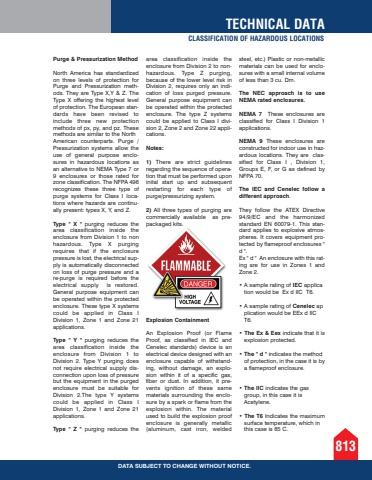Page 845 - Demo
P. 845
813TECHNICAL DATADATA SUBJECT TO CHANGE WITHOUT NOTICE.Purge & Pressurization Method North America has standardized on three levels of protection for Purge and Pressurization methods. They are Type X,Y & Z. The Type X offering the highest level of protection. The European standards have been revised to include three new protection methods of px, py, and pz. These methods are similar to the North American counterparts. Purge / Pressurization systems allow the use of general purpose enclosures in hazardous locations as an alternative to NEMA Type 7 or 9 enclosures or those rated for zone classification. The NFPA 496 recognizes these three type of purge systems for Class I locations where hazards are continually present: types X, Y, and Z. Type \area classification inside the enclosure from Division 1 to non hazardous. Type X purging requires that if the enclosure pressure is lost, the electrical supply is automatically disconnected on loss of purge pressure and a re-purge is required before the electrical supply is restored. General purpose equipment can be operated within the protected enclosure. These type X systems could be applied in Class I Division 1, Zone 1 and Zone 21 applications. Type \area classification inside the enclosure from Division 1 to Division 2. Type Y purging does not require electrical supply disconnection upon loss of pressure but the equipment in the purged enclosure must be suitable for Division 2.The type Y systems could be applied in Class I Division 1, Zone 1 and Zone 21 applications. Type \area classification inside the enclosure from Division 2 to nonhazardous. Type Z purging, because of the lower level risk in Division 2, requires only an indication of loss purged pressure. General purpose equipment can be operated within the protected enclosure. The type Z systems could be applied to Class I division 2, Zone 2 and Zone 22 applications. Notes: 1) There are strict guidelines regarding the sequence of operation that must be performed upon inital start up and subsequent restarting for each type of purge/pressurizing system. 2) All three types of purging are commercially available as prepackaged kits. Explosion ContainmentAn Explosion Proof (or Flame Proof, as classified in IEC and Cenelec standards) device is an electrical device designed with an enclosure capable of withstanding, without damage, an explosion within it of a specific gas, fiber or dust. In addition, it prevents ignition of these same materials surrounding the enclosure by a spark or flame from the explosion within. The material used to build the explosion proof enclosure is generally metallic (aluminum, cast iron, welded steel, etc.) Plastic or non-metallic materials can be used for enclosures with a small internal volume of less than 3 cu. Dm. The NEC approach is to use NEMA rated enclosures. NEMA 7 These enclosures are classified for Class I Division 1 applications. NEMA 9 These enclosures are constructed for indoor use in hazardous locations. They are classified for Class I , Division 1, Groups E, F, or G as defined by NFPA 70. The IEC and Cenelec follow a different approach. They follow the ATEX Directive 94/9/EC and the harmonized standard EN 60079-1. This standard applies to explosive atmospheres. It covers equipment protected by flameproof enclosures \d \Ex \ing are for use in Zones 1 and Zone 2. %u2022 A sample rating of IEC application would be Ex d IIC T6. %u2022 A sample rating of Cenelec application would be EEx d IIC T6. %u2022 The Ex & Eex indicate that it is explosion protected. %u2022 The \of protection, in the case it is by a flameproof enclosure. %u2022 The IIC indicates the gas group, in this case it is Acetylene. %u2022 The T6 Indicates the maximum surface temperature, which in this case is 85 C. CLASSIFICATION OF HAZARDOUS LOCATIONS


